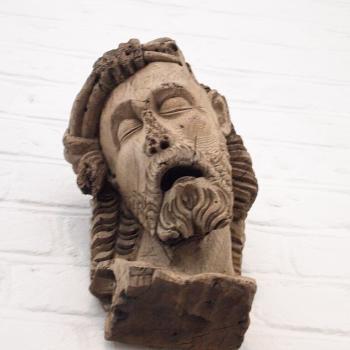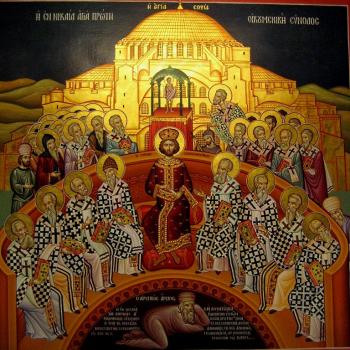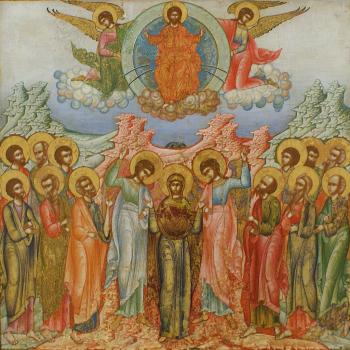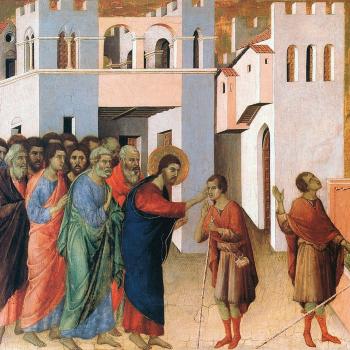Champion of Orthodoxy, teacher of purity and of true worship, enlightener of the universe and adornment of hierarchs: all-wise father Maximus, your teachings have gleamed with light upon all things. Intercede before Christ God to save our souls (Troparion for the Feast of the Translation of the Relics of St. Maximos the Confessor)
St. Maximos (Maximus) the Confessor was one of the most erudite theological writers of the patristic age. His claim to fame, his status as being a confessor, lay with his defense of orthodox Christology by pointing out the proper implications of the teachings at Chalcedon. That is, Jesus, although he is one person, possesses two wills and energies, one for each of his natures (God and man). He confronted Byzantine officials, including his Patriarch, who tried to force a conciliation between critics of Chalcedon with Chalcedonians by suggesting that Christ had only one will. The Pope of Rome, St. Martin, opposed the Byzantine synthesis, causing Byzantine officials to imprison him, torture him, and later send him into exile (instead of executing him as was their original intention). St. Maximos, affirming Pope St. Martin, faced a similar grueling trial, imprisonment, torture, and exile. Both St. Martin and St. Maximos the Confessor, due to their age and what they suffered by the hands of Byzantine officials, quickly died in exile. Although their deaths could be attributed, in part, to the torture they suffered, since they died only indirectly from what had been done to them, they are labelled confessors of the faint instead of martyrs, but it is easy to see their trials and tribulations were the same as many of the martyrs before them.
While debating Maximos, the Patriarch of Constantinople, Pyrrhus, tried to tell him that the previous Pope of Rome, Honorius, agreed with the monothelites; it is a claim which has often been made against Honorius, but it was one which St Maximos entirely rejected. While there was a letter which, at first glance, might suggest Honorius was a monothelite, St. Maximos pointed out that the letter must be read within its proper context, whereby the “one will” mentioned in the letter concerned Christ’s human nature:
PYRRHUS: Let us leave the question of Vigilius. What dost thou say of Honorius, who clearly taught one will of our Lord Jesus Christ in his letter to my predecessor?
MAXIMUS: Who is a more trustworthy interpreter of such an epistle? The one that actually wrote it for Honorius, the one who at that time was still alive, and who, in addition to all his other virtues, illumined the whole West with godly dogmas? Or is it those in Constantinople who [interpret it in accordance with] the whim of their own hearts?
PYRRHUS: The one who actually composed the letter.
MAXIMUS: This same person afterwards wrote for Pope John (who is among the saints) to Constantine, just after he had become Emperor regarding the very same [letter of Honorius]. He explained that “We say one will of the Lord, not of the Godhead and humanity, but only for the humanity. For Sergius hath written: ‘As some say that the two wills of Christ are opposed, we in response write that Christ did not have two opposing wills, but one only, that which characterized His humanity by virtue of nature.’” And the clear proof of this is the fact that he writteth of limbs and flesh, which means that we cannot apply what he saith unto the Godhead. Straight away, in anticipation of objections, he saith, “And if someone saith, ‘Why, when speaking of the humanity of Christ, did you not refer to the Godhead as well?’ we reply, for the first part, that our answer was made to a specific question; and for the second, part, that there, as ever, we have followed the practice of Scripture. For sometimes it speaketh concerning His Godhead only, as when the apostle saith: ‘Christ the power of God and wisdom of God’, and sometimes concerning only His humanity, as when the apostles saith ‘the foolishness of God is stronger than mean’, and what is weak in God is stronger then men.’”[1]
St. Maximos brought up a very important point in the debate. It is easy for people to misread theological documents when they are read out of context. The context of Honorius’s letter is very important, because by understanding the questions involved, it is clear that it was not stating Jesus had only one, but rather, he had only one human will. Why would there be any suggestion otherwise? Because, there was some speculation which suggested that humans generally had two different, indeed, opposing wills directing them to contradictory ends, one promoting the good activities, the other promoting evil ones. They were seen to be at war within everyone, a war which explained the various temptations we faced, and the end result of the war was determined by what choices we made in relation to the two differing wills. It was this speculation which motivated the letter asking for Honorius’ understanding of Christ’s humanity. Because Jesus could be tempted, did he have two conflicting wills coming from his human nature? Honorius answered, following orthodox teaching, that there is but one will in Christ’s humanity and there is no war within him, no internal conflict, leading him to two contradictory ends (one being good, one being evil). Not only does this help vindicate Honorius, it points to the difficulty which can be had when we read and interpret ancient documents without understanding the context in which they were written: indeed a text being interpreted without understanding its proper context easily leads to someone to promote their own ideologies through the text instead of letting the text represent itself and the teachings intended by them. In his response to Pyrrhus, St. Maximos pointed out that the one who wrote the letter for Pope Honorius, who later wrote letters for his successor, should be consulted in order to understand the intent with the letter, and in doing so, the context and meaning of the letter could properly be ascertained. This is an important lesson for us. When we read difficult or controversial material which seems to have been isolated from their greater context, it is easy to see a particular pretext is often involved with the way the text is isolated and used as a prooftext, which is why we must be suspicious with such proof-texting and investigate further before accepting it.
Thus, to understand St. Maximos and his Christology, it is best to look at the works he wrote before the monothelite controversy broke out. That way, we not only understand his Christology but we can learn the practical ramifications that can come as a result of his thoughts. When doing so, the Chalcedonian nature of his thought shines through. Through them, we can find him saying that we must consider Christ according to his singular hypostasis as well as through his two natures:
In other words, so long as you contemplate Christ as a single hypostasis, the coupling of the attributes in their mutual interchange is indivisible; but when, on the other hand, you separate in your thoughts the two natures that complete the one hypostasis in Christ, you simultaneously divide the attributes together with the natures. [2]
The division of attributes does not mean the hypostasis is to be divided, for Christ is one, but it means that we can and should recognize the distinction between his humanity and his divinity. The two are united through the hypostatic union, but they remain unconfused, and so distinct from each other. They act, and so also reveal themselves, according to their nature. He reveals his humanity through human acts and he reveals his divinity through divine acts. This is why Jesus is said to have two wills, each with their own particular activities, working together and yet in their own distinct fashion, so that Christ, who is one, wills one end through both of them, each working and contributing to that one end in their own way. Understanding the two natures this way helps us understand how and why union, in and of itself, does not mean the confusion of two different things into one (new) things. This is important because it helps us understand our union with Christ. The whole of creation, including the whole of humanity, is brought together as one without confusion: they share one end together, but they do so without losing themselves by becoming some new third creature or by becoming absorbed by such unity:
For numerous and of almost infinite number are the men, women, and children who are distinct from one another and vastly different by birth and appearance, by nationality and language, by customs and age, by opinions and skills, by manners and habits, by pursuits and studies, and still again by reputation, fortune, characteristics, and connections: All are born into the Church and through it are reborn and recreated in the Spirit. To all in equal measure it gives and bestows one divine form and designation, to be Christ’s and to carry his name. In accordance with faith it gives to all a single, simple, whole, and indivisible condition which does not allow us to bring to mind the existence of the myriads of differences among them, even if they do exist, through the universal relationship and union of all thing with it. It is through it that absolutely no one at all is in himself separated from the community since everyone converges with all the rest and joins together with them by the one, simple, and indivisible grace and power of faith.[3]
In this way, St. Maximos gives us a way to understand why the church, being the one body of Christ, nonetheless is said to have many members with their own particular distinction (cf. 1Cor. 12:12-26). Just as a body is one and whole and works together as one, nonetheless the different members of the body have their own particular qualities and characteristics, and in the union of all things in Christ, all things are incorporated in Christ without absorption, without their own particular qualities being annihilated. “God realizes this union among the natures of things without confusing them but in lessening and bringing together their distinction, as was shown, in a relationship and union with himself as cause, principle, and end.” [4] And, just as a stomach will be acting in one way, lungs another, while working together and establishing one particular end together (what is done to the body as a whole), so we can then understand the two natures of Christ coming together, willing their own particular actions while not being divided and in opposition from each other due to their unique engagements; likewise, then, we can understand how the various parts of creation come together and work together for one end in Christ.
What St. Maximos saw was dangerous with the monothelite position was what earlier fathers saw was dangerous with the monophysite position: it was a union of confusion, of things merging together and blending them together where nothing remained after the union of those distinct qualities and elements which had come together. Orthodox teaching recognized that if such confusion was the end result of union, then we, who find ourselves united in Christ, will find ourselves absorbed in him: what, then, would distinguish eternal life from annihilation? St. Maximos, therefore, found it important to point out the fact that all things will be united as one in Christ, such unity, following the teaching of Chalcedon, must not be misunderstood as destroying what is demonstrated in the distinctions found in creation.
St. Maximos is an important theologian in regards the cosmic, universal work of Christ. He promoted the notion that Christ united all things in himself. But he understood how the hypostatic union did not destroy the distinct qualities of Christ’s two natures, and so the union of all things must not be misinterpreted as some sort of monistic end. Christ’s humanity had to continue to will as a human: if it did not, then humanity would find itself lost in Christ. What use would Christ’s salvific work be for us if, through it, we found ourselves lost in the equation? This is why St. Maximos could not and would not allow others, like Pyrrhus, to promote a false view of Christ, where human willing was overcome by Christ’s divinity.
[1] St. Maximus the Confessor, The Disputation with Pyrrhus. Trans. Joseph P. Farrell (South Canaan, PA: St. Tikhon’s Seminary Press, 1990), 49-50.
[2] St. Maximos the Confessor, On Difficulties in the Church Fathers: The Ambigua. Volume II. Trans. Nicholas Constas (Cambridge: Harvard University Press, 2014), 29 [Amb.27].
[3] St. Maximus the Confessor, “The Church’s Mystagogy” in Maximus the Confessor: Selected Writings. trans. George C. Berthold (New York: Paulist Press, 1985), 187.
[4] St. Maximus the Confessor, “The Church’s Mystagogy,” 188.
Stay in touch! Like A Little Bit of Nothing on Facebook.
If you liked what you read, please consider sharing it with your friends and family!













